Program Accomplishments
LDRD-funded research explores the frontiers of science and technology in emerging mission spaces, with projects guided by an extremely creative, talented team of scientists and engineers.
Featured Research
LDRD funded 266 projects in the fiscal year 2023. Brief summaries of each project are included in the Project Highlights section. Here, we provide a closer look at a handful of projects that underscore the exciting, innovative research in this year’s LDRD portfolio.
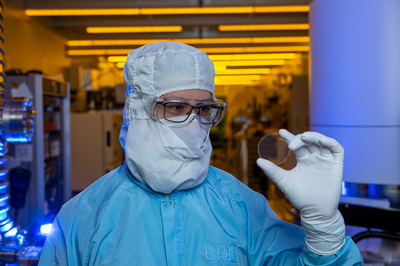
Optics researchers at Lawrence Livermore National Laboratory (LLNL) have refined their novel metasurface process to create taller features without increasing feature-to-feature spacing, an advance that unlocks exciting new design possibilities.
“We have refined our process to create metasurfaces that allow for a wide optical bandwidth and a large span of incidence angles for an antireflection layer,” said LLNL research scientist Eyal Feigenbaum, the principal investigator. “We can now cover bandwidth range all the way from the ultraviolet to wavelengths larger than 2 microns, which is extraordinary. That wasn’t possible with the existing technology.”
The result is reported in a new paper, “All-Glass Metasurfaces for Ultra-Broadband and Large Acceptance Angle Antireflectivity: from Ultraviolet to Mid-Infrared,” the cover story for the December 2023 issue of Advanced Optical Materials.
Metasurface is an approach to optics design in which the surface of a material is carefully altered, creating an ultrathin “metasurface” with properties that differ from those within the bulk of the material by introducing features smaller than the optical wavelength. Feigenbaum’s team have been developing a scalable process for engraving metasurfaces into fused silica glass, part of a Laboratory Directed Research and Development project ending this year.
The LLNL method seeks to replace the need for broadband anti-reflective (AR) coatings with a metasurface that is monolithic to the optic — essentially becoming a seamless part of the optic — to enhance its endurance and stability. Furthermore, the team has presented and continues developing different alterations of this method for implementing sub-micron thick optical elements, such as lenses, and polarization altering waveplates.
For the National Ignition Facility (NIF) and other advanced laser systems, such metasurface optics could be transformative, replacing multiple optics with a single, more robust, slimmer optic.
Their four-step process, consisting of ultrathin metal film deposition, dewetting, etching and mask removal, results in an all-glass metasurface. While relatively simple, the process provides substantial tunability and control over metasurface features. Their most recent advances came from two significant changes to their process: changing the deposition material from gold to platinum and advancing the dewetting mask technology.
“This is what allowed us to etch deep features while maintaining the same feature spacing,” said LLNL staff research scientist Nathan Ray, the lead author of this study.
The challenge in producing a metasurface that operates over a broad band of wavelengths is manufacturing a feature height-to-width aspect ratio that is large enough. For that purpose, the nanofeatures' widths and spacing must be made smaller than the shortest wavelength, while the depth of the nanofeatures must be close to half of the longest wavelength in the band of operation.
The team invented a technique they call “seeded dewetting,” which allows increasing the mask nanoparticle height while maintaining the inter-particle spacing. For the metasurface to function as an AR, the inter-particle spacing must be substantially smaller than the light wavelength, yet the height of the mask nanoparticle determines how tall the metasurface features can be made.
Traditional dewetting has a limited design space, since an increase in the nanoparticle height goes hand-in-hand with an increase in the inter-particle spacing. The researchers found that seeded dewetting, or subsequent depositions and dewetting of ultrathin metal film on top of preexisting nanoparticle “seeds,” maintains the original inter-particle spacing while each step steadily increases the height due to metal accumulation around the initial nanoparticle seeds.
Using this advanced mask technology, they were able to create metasurfaces with nanoscale all-glass metasurface features with height-to-width ratio as large as about 14, where the mean base diameter of the cone-like features is 62 nanometers. They demonstrated this metasurface on both sides of a 2-inch-diameter fused silica window.
The AR performance of such an optic is capable of eliminating reflected light over unprecedented wavelength ranges covering ultraviolet, visible, and infrared, both P- and S-polarizations, and a broad range of acceptance angles. Such optics could enhance the efficiency of light delivered through protective windows of photovoltaic cells, the throughput of multiharmonic lasers, and laser systems that combine beams from different angles or that dynamically vary the beam direction over large angular spans.
“This technology could be transformative for solar-cell windows,” explains Ray. “Using current AR technologies on protective window coverings for solar cells, the efficiency of the AR coating depends on the angle it makes with the sun and the wavelength of the incident light and is polarization dependent. The metasurface optic we demonstrated works for a wide range of angles — so there is no need to move the cell — handles both polarizations and demonstrates near-negligible reflection over the entire solar spectrum.”
Metasurface optics using this technology could enable a broader design space for the variety of lasers developed for and operated at LLNL, with monolithic antireflective coatings also providing robustness and endurance for use with high-powered lasers.
The researchers are now working to tailor the AR to specific applications, apply the methodology to substrates beyond the fused silica glass used to make many of NIF’s optics, and increase the scale. Two inches is large in the world of optics, but quite small in comparison to those found in NIF.
LDRD Project Title: Glass-Engraved Meta-Optics for High-Power Lasers
Principal Investigator:
Eyal Feigenbaum
LDRD Project:
21-ERD-002

Colorectal cancer (CRC) — cancer of the colon or rectum — is the third-most common cancer in both men and women in the United States and the second-most common cause of cancer-related death in developed countries.
Although surgery is highly successful for patients with a localized disease or disease confined to a narrow region (stages I–III), a total of 60% of CRC patients are diagnosed with Stage IV liver metastasis (CRCLM), for which surgery is insufficient. While combination regimes of chemotherapeutic agents and targeted therapies benefit some patients, the five-year relative survival rate for metastatic CRC remains just 14%. Thus, there is an urgent need to develop additional therapies for CRCLM.
In fact, patient-derived organoids (PDOs) — sampled patient tissue — are emerging as reliable preclinical tools to develop and test therapies for metastatic CRC. PDOs have been shown to mimic drug response behavior of the tumor from which they are derived and retain genomic and some phenotypic characteristics of the original tumor. Therefore, PDOs can be used as models to understand patient-specific drug responses and investigate cancer cell growth.
However, because studying drug transport in tumors in vivo is complex, in vitro platforms are also needed to better understand tumor progression and treatment resistance. In support of this need, Lawrence Livermore National Laboratory scientists and collaborators have developed a platform capable of studying CRCLM PDO response to various chemotherapeutic gradients. Their research is detailed in a recent Frontiers in Bioengineering and Biotechnology paper.
The team’s perfused multi-well bioreactor platform was designed around a standard 12-well cell culture plate to minimize the number of custom parts and enable easy assembly. This layout provides 12 independently fed wells that can be used to study multiple drug concentrations or combinations in one experiment.
When testing this platform, the team investigated how tumor organoids respond to a common cancer drug treatment, 5-fluorouracil (5-FU), in varying environments. Patient-derived colorectal liver metastasis organoids were cultured in the multi-well bioreactor platform and organoid response was compared to organoids cultured in media and static hydrogel, which are two common PDO culture models routinely used for drug testing. Researchers ran computer simulations prior to testing to determine how the drug would be distributed in each platform.
The simulation verified that after seven days of exposure to 5-FU in the bioreactor, a concentration gradient formed, reaching a higher average concentration close to the channel (region 1) and a lower average concentration far from the channel (region 2). This gradient correlates to a lower viability in region 1 than region 2. The simulation results helped ensure the cumulative dose the organoids received for the duration of the experiment were comparable across platforms.
Despite the organoids in each condition receiving comparable cumulative doses of drugs, organoids cultured in media had a significantly lower viability, suggesting that cumulative dose alone does not explain differences in cell viability and that culturing PDOs in a 3D hydrogel influences drug response. Additionally, organoids in media were immediately exposed to 5-FU while the static gel and bioreactor were exposed slowly as the drug diffused through the hydrogel.
“Our results demonstrate the platform’s ability to generate gradient conditions and test multiple drug concentrations on PDOs at once while also highlighting the importance of using transport simulations to properly assess culture environment and obtain accurate interpretations of drug response,” said LLNL scientist Elisa Wasson. “Using our platform and transport modeling, flow parameters may be tuned to control these gradients and enable testing of a range of therapeutic agents and different dosing strategies.”
Future studies could utilize the platform to investigate how other microenvironmental gradients such as oxygen or tumor promoting soluble factors influence PDO drug response. Additionally, tumor-immune interactions may be investigated by circulating immune cells through the channel and observing invasion into the surrounding PDOs loaded hydrogel.
LDRD Project Title: Engineered and Instrumented Three-Dimensional Tumor-Immune Model System
Principal Investigator:
Elizabeth Wheeler
LDRD Project:
19-SI-003
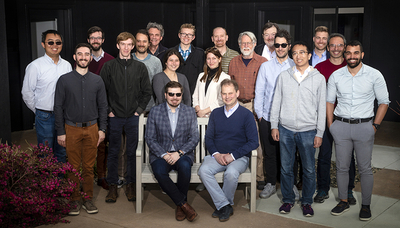
An international collaboration of researchers from Lawrence Livermore National Laboratory (LLNL) and other scientific institutions is ramping up its studies into “sterile neutrinos” to discover and better understand dark matter.
Sterile neutrinos are theoretically predicted new particles that offer an intriguing possibility in the quest for understanding the dark matter in our universe.
Unlike the known “active” neutrinos in the Standard Model (SM) of particle physics, these sterile neutrinos do not interact with normal matter as they move through space, making them very difficult to detect.
Scientists from four countries, led by LLNL and the Colorado School of Mines, have demonstrated the power of using nuclear decay in high-rate quantum sensors in the search for sterile neutrinos. Their findings, initially made in 2021, are the first measurements of this kind.
The primary aim of the team’s research is to seek out one of the most promising candidates for dark matter, the strange unidentified material that permeates the universe and accounts for 85% of its total mass.
In early April, 25 physicists and material scientists from the collaboration — known as “BeEST,” for Beryllium Electron-capture with Superconducting Tunnel junctions — met for two days at the University of California Livermore Collaboration Center.
Among those participating were researchers from LLNL, the Colorado School of Mines, Vancouver-based TRIUMF, Canada’s particle accelerator center; the University of Strasbourg (France), the NOVA University of Lisbon (Portugal) and two companies — Santa Fe, N.M.-based STAR Cryoelectronics and Oakland-based XIA.
LLNL physicist Stephan Friedrich leads the LLNL portion of the sterile neutrino collaboration. Friedrich’s team at LLNL includes physicists In Wook Kim and Geon-Bo Kim, who analyze experimental data, researchers Amit Samanta and Vince Lordi, who perform the material science simulations and Connor Bray, a physics graduate student from the Colorado School of Mines, who will do his thesis project on this experiment.
The team’s LLNL experiment involves implanting radioactive beryllium-7 atoms into superconducting sensors developed at Livermore. When the beryllium-7 decays by electron capture into lithium-7 and a neutrino, the neutrino escapes from the sensor, but the recoil energy of the lithium-7 provides a measure of the neutrino mass. If a heavy sterile neutrino were to be generated in a fraction of the decays, the lithium-7 recoil energy would be reduced and produce a measurable signal, even though the elusive neutrino itself is not directly detected.
Friedrich describes the sterile neutrino search problem in this manner: how do you find something that doesn’t emit light, doesn’t absorb light and doesn’t interact with material except through its mass? He likens the sterile neutrino search to firing a gun.
“If you know how much gun powder [or energy] you have and you can measure the recoil, then you can infer the properties of the bullet. The energy of the recoil is a measure of the energy and mass of the projectile,” Friedrich said, “just like the energy of the lithium-7 recoil is a measure of the energy and the mass of the neutrino.”
Friedrich helped develop a set of radiation detectors known as superconducting tunnel junctions (STJs) while he was a Ph.D. student at Yale University in the 1990s. These detectors consist of two metal films separated by a thin insulator, and they are cooled to ultra-low temperatures close to absolute zero, or -459 degrees Fahrenheit, so that they become superconducting and can act as high-precision detectors.
He initially developed the detectors for X-ray astronomy for NASA and later for experiments at Lawrence Berkeley’s Advanced Light Source to understand how plants produce oxygen. In 2018, Friedrich met Kyle Leach, a nuclear physicist at the Colorado School of Mines, who suggested that the STJ detectors would be perfect for detecting sterile neutrinos.
The LLNL sterile neutrino research started in 2019 and received three-and-a-half years of Laboratory Directed Research and Development funding before bridging over to funding from the Department of Energy’s Office of Nuclear Physics.
In their initial one-month experiment with a single STJ detector, the data excluded the existence of sterile neutrinos in the mass range of 100 to 850 kiloelectron volts down to a 0.01% level of mixing with the active neutrinos — better than all previous decay experiment in this range.
“Since that time, we’ve been working to make our experiments bigger and better and therefore more sensitive,” Friedrich said.
In their recent experiments, the team has run 20 sensors for two months with a higher dose of beryllium-7, taking some 160 terabytes of high-quality data that is now undergoing analysis, according to Friedrich. Future experiments are expected to run 100 sensors for three months and will be among the world’s most sensitive searches for a suite of potential new “dark” particles.
LDRD Project Title: A Search for Sterile Neutrino Dark Matter
Principal Investigator:
Stephan Friedrich
LDRD Project:
20-LW-006
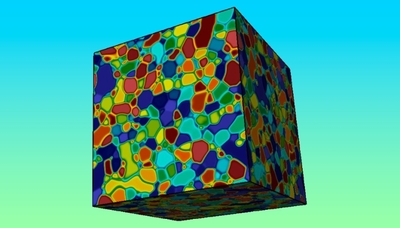
Titanium (Ti) and its alloys are attractive for a wide variety of structural and functional applications due to the metal’s excellent strength, toughness and stiffness, and corrosion resistance. Specific applications include lightweight structural materials, bioimplants, and energy storage materials. However, if exposed to hydrogen sources, these alloys are susceptible to hydrogen incorporation and hydride formation, leading to crack initiation and mechanical failure resulting from lattice deformation and stress accumulation. When it comes to understanding hydrogenation and hydride formation in Ti alloys, many unanswered questions and challenges remain.
In a recent perspective article, LLNL researchers and collaborators propose new ideas on how to solve these issues and close knowledge gaps by discussing and demonstrating specific opportunities for integrating advanced characterization and multiscale modeling to elucidate chemistry and composition, microstructure phenomena, and macroscale performance and testing. The team’s paper draws on their own work, as well as a contextual review of existing literature studies focused on the integration of novel experimental and computational tools for a detailed mechanistic understanding. Their research aligns with an LLNL strategic initiative on corrosion science, supporting critical mission areas related to materials aging, degradation, energy, and climate security.
Overall, the team’s research emphasizes that because combined theory–experiment approaches can uniquely and holistically investigate surface morphology, chemical composition, and hydrogen transport, future investments along these lines will be crucial. Such investments, if properly realized, can guide forthcoming strategies for slowing hydriding of Ti alloys in corrosion-resistant structural applications.
LDRD Project Title: Predicting and Controlling Corrosion
Principal Investigator:
Brandon Wood
LDRD Project:
20-SI-004
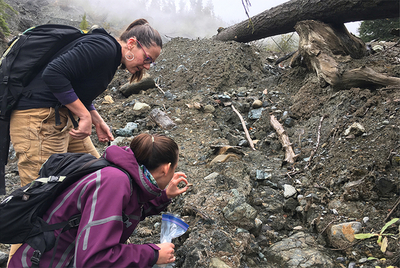
Carbonate minerals are formed when carbon dioxide reacts with magnesium and calcium-rich rocks. But where does that CO2 come from?
If it comes from the atmosphere, this process at sufficient scale may be able to reliably draw down atmospheric greenhouse gas levels, according to new research by Lawrence Livermore National Laboratory (LLNL) scientists. The research appears in the journal Nuclear Instruments and Methods in Physics Research.
Carbon mineralization — the formation of solid carbonate minerals from CO2— is one of the most stable methods for sequestering carbon. This process occurs naturally at the Earth’s surface when magnesium (Mg)- and calcium (Ca) - enriched rock types, known as ultramafics, are exposed to CO2-rich water. After CO2 dissolves in water to form bicarbonate, it can react with the Mg or Ca ions released during rock weathering. Previous work has demonstrated that they actively draw down local carbon dioxide (CO2) concentrations.
But there hasn’t been a method for unambiguously attributing the sequestered carbon solid product to atmospheric sources until now. LLNL researchers used radiocarbon to verify that the carbon being incorporated into carbonate minerals during carbon mineralization is atmospheric in origin.
“We were able to identify some environments and locations where all the carbon in the carbonates almost certainly came from the atmosphere,” said LLNL scientist Kari Finstad, lead author of the paper. “It proved what we suspected, that carbonate minerals passively forming in these ultramafic environments are naturally sequestering atmospheric CO2.”
This passive reaction is well-documented at mine sites composed of processed ultramafic material. Previous work demonstrated that these mine and tailings wastes actively convert available CO2 to more stable solid carbonate materials, but future large-scale implementation of this process to mitigate climate change will require a method to “fingerprint” both the nature and quantity of the CO2 source in the final material (e.g., “new” atmospheric versus geologically “old” and recycled carbon).
If only atmospheric CO2 is incorporated into a material (as opposed to CO2 derived from other geological, biological or anthropogenic processes), then the radiocarbon (carbon 14) content of the material should match that in the atmosphere at the time of formation.
“The radiocarbon content of carbonates may provide a unique tool for verifying the sequestration of atmospheric CO2 and determining the proportion of the carbon that is atmospheric in origin,” Finstad said.
LDRD Project Title: Determining the Rate of Natural Carbonate Precipitation Using Bomb-Pulse Radiocarbon Dating
Principal Investigator:
Kari Finstad
LDRD Project:
18-FS-024
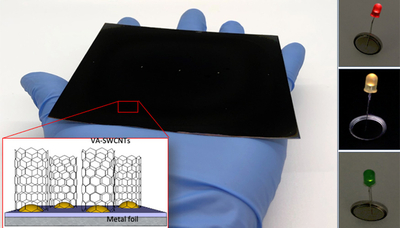
Lawrence Livermore National Laboratory (LLNL) scientists have created vertically aligned single-walled carbon nanotubes on metal foils that could be a boon for energy storage and the electronics industry.
Vertically aligned carbon nanotubes (VACNTs) have exceptional mechanical, electrical and transport properties in addition to an aligned architecture, which is key for applications such as membrane separation, thermal management, fiber spinning, electronic interconnects and energy storage.
To date, widespread integration of VACNTs into next-generation technologies is thwarted by a lack of compatible, economic, mass-production capabilities. High-quality VACNTs are typically made on substrates such as silicon (Si) or quartz wafers that are rigid, expensive and electrically insulating.
After exploring metal foil options in scientific literature, the LLNL team turned to Inconel metal substrates allowing them to integrate VACNTs into flexible devices, eliminate a transfer step from Si to other substrates and minimize electrical or thermal transport resistances at the interface between CNTs and the substrate, which is critical for electronic and energy storage applications. Inconel is a family of nickel-chromium-based superalloys that are oxidation-corrosion-resistant materials well-suited for service in extreme environments subjected to pressure and heat.
“Transitioning growth of high-quality CNTs from traditional Si substrates to metal foils opens the door to more economical, large-scale, semicontinuous and roll-to-roll manufacturing of multifunctional CNT composites, nanoporous membranes and electrochemical devices,” said LLNL scientist Francesco Fornasiero, co-author of a paper appearing in the journal Applied Materials & Interfaces.
Synthesis of high-quality single-walled CNTs (SWCNTs) on metal foils would be especially valuable for energy-storage devices, such as lithium-ion batteries (LIBs). While graphitic materials are common LIB anodes, their capacity falls short of rapidly evolving energy-storage needs. “The high surface area and exceptional electronic conductivity of CNTs make them prime candidates for high-capacity, high-rate electrochemical applications,” said LLNL scientist Kathleen Moyer-Vanderburgh, lead author of the paper. “In particular, VA-SWCNTs grown on metal foils could provide a binder-free platform with strong adhesion between the SWCNT and current collector, enhanced conductivity and aligned channels for rapid Li-ion diffusion.”
The LLNL team grew forests of vertically aligned SWCNT on Inconel metal for use as a LIB anode. Team members found nearly invariant structural properties of the CNT forests over a wide range of synthesis conditions and for multiple metal substrates. Fabricated VA-SWCNT LIB anode displayed stable cycling for hundreds of cycles and large capacity even at high cycling rates.
“Our results suggest that these SWCNTs on Inconel metal are promising materials for high-performance electrochemical devices,” said LLNL scientist Jianchao Ye.
LDRD Project Title: Overcoming Cycling Limitations for High-Energy-Density Lithium-Ion Batteries
Principal Investigator:
Kathleen Vanderburgh
LDRD Project:
21-LW-020
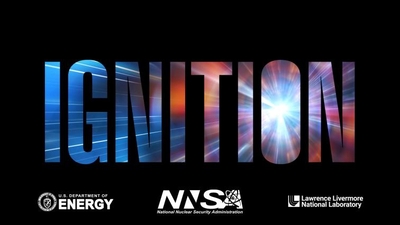
The U.S. Department of Energy (DOE) and DOE’s National Nuclear Security Administration (NNSA) announced the achievement of fusion ignition at Lawrence Livermore National Laboratory (LLNL) — a major scientific breakthrough decades in the making that will pave the way for advancements in national defense and the future of clean power. On Dec. 5, 2022, a team at LLNL’s National Ignition Facility (NIF) conducted the first controlled fusion experiment in history to reach this milestone, also known as scientific energy breakeven, meaning it produced more energy from fusion than the laser energy used to drive it. This first-of-its-kind feat will provide unprecedented capability to support NNSA’s Stockpile Stewardship Program and will provide invaluable insights into the prospects of clean fusion energy, which would be a game-changer for efforts to achieve President Biden’s goal of a net-zero carbon economy.
“This is a landmark achievement for the researchers and staff at the National Ignition Facility who have dedicated their careers to seeing fusion ignition become a reality, and this milestone will undoubtedly spark even more discovery,” said U.S. Secretary of Energy Jennifer M. Granholm. “The Biden-Harris Administration is committed to supporting our world-class scientists — like the team at NIF — whose work will help us solve humanity’s most complex and pressing problems, like providing clean power to combat climate change and maintaining a nuclear deterrent without nuclear testing.”
“We have had a theoretical understanding of fusion for over a century, but the journey from knowing to doing can be long and arduous. Today’s milestone shows what we can do with perseverance,” said Dr. Arati Prabhakar, the President’s chief adviser for Science and Technology and director of the White House Office of Science and Technology Policy.
“Monday, December 5, 2022, was a historic day in science thanks to the incredible people at Livermore Lab and the National Ignition Facility. In making this breakthrough, they have opened a new chapter in NNSA’s Stockpile Stewardship Program,” NNSA Administrator Jill Hruby said. “I would like to thank the members of Congress who have supported the National Ignition Facility because their belief in the promise of visionary science has been critical for our mission. Our team from around the DOE national laboratories and our international partners have shown us the power of collaboration.”
“The pursuit of fusion ignition in the laboratory is one of the most significant scientific challenges ever tackled by humanity, and achieving it is a triumph of science, engineering, and most of all, people,” LLNL Director Dr. Kim Budil said. “Crossing this threshold is the vision that has driven 60 years of dedicated pursuit — a continual process of learning, building, expanding knowledge and capability, and then finding ways to overcome the new challenges that emerged. These are the problems that the U.S. national laboratories were created to solve.”
~ LLNL Director Dr. Kim Budil
“This astonishing scientific advance puts us on the precipice of a future no longer reliant on fossil fuels but instead powered by new clean fusion energy,” U.S. Senate Majority Leader Charles Schumer (NY) said. “I commend Lawrence Livermore National Labs and its partners in our nation’s Inertial Confinement Fusion (ICF) program, including the University of Rochester’s Lab for Laser Energetics in New York, for achieving this breakthrough. Making this future clean energy world a reality will require our physicists, innovative workers and brightest minds at our DOE-funded institutions, including the Rochester Laser Lab, to double down on their cutting-edge work. That’s why I’m also proud to announce today that I’ve helped to secure the highest-ever authorization of over $624 million this year in the National Defense Authorization Act for the ICF program to build on this amazing breakthrough.”
“After more than a decade of scientific and technical innovation, I congratulate the team at Lawrence Livermore National Laboratory and the National Ignition Facility for their historic accomplishment,” said U.S. Senator Dianne Feinstein (CA). “This is an exciting step in fusion and everyone at Lawrence Livermore and NIF should be proud of this milestone achievement.”
This is an historic, innovative achievement that builds on the contributions of generations of Livermore scientists. Today, our nation stands on their collective shoulders. We still have a long way to go, but this is a critical step and I commend the U.S. Department of Energy and all who contributed toward this promising breakthrough, which could help fuel a brighter clean energy future for the United States and humanity,” said U.S. Senator Jack Reed (RI), the chairman of the Senate Armed Services Committee.
“This monumental scientific breakthrough is a milestone for the future of clean energy,” said U.S. Senator Alex Padilla (CA). “While there is more work ahead to harness the potential of fusion energy, I am proud that California scientists continue to lead the way in developing clean energy technologies. I congratulate the scientists at Lawrence Livermore National Laboratory for their dedication to a clean energy future, and I am committed to ensuring they have all of the tools and funding they need to continue this important work.”
“This is a very big deal. We can celebrate another performance record by the National Ignition Facility. This latest achievement is particularly remarkable because NIF used a less spherically symmetrical target than in the August 2021 experiment,” said U.S. Representative Zoe Lofgren (CA-19). “This significant advancement showcases the future possibilities for the commercialization of fusion energy. Congress and the Administration need to fully fund and properly implement the fusion research provisions in the recent CHIPS and Science Act and likely more. During World War II, we crafted the Manhattan Project for a timely result. The challenges facing the world today are even greater than at that time. We must double down and accelerate the research to explore new pathways for the clean, limitless energy that fusion promises.”
LLNL’s experiment surpassed the fusion threshold by delivering 2.05 megajoules (MJ) of energy to the target, resulting in 3.15 MJ of fusion energy output, demonstrating for the first time a most fundamental science basis for inertial fusion energy (IFE). Many advanced science and technology developments are still needed to achieve simple, affordable IFE to power homes and businesses, and DOE is currently restarting a broad-based, coordinated IFE program in the United States. Combined with private-sector investment, there is a lot of momentum to drive rapid progress toward fusion commercialization.
Fusion is the process by which two light nuclei combine to form a single heavier nucleus, releasing a large amount of energy. In the 1960s, a group of pioneering scientists at LLNL hypothesized that lasers could be used to induce fusion in a laboratory setting. Led by physicist John Nuckolls, who later served as LLNL director from 1988 to 1994, this revolutionary idea became inertial confinement fusion, kicking off more than 60 years of research and development in lasers, optics, diagnostics, target fabrication, computer modeling and simulation and experimental design.
To pursue this concept, LLNL built a series of increasingly powerful laser systems, leading to the creation of NIF, the world’s largest and most energetic laser system. NIF — located at LLNL in Livermore, California — is the size of a sports stadium and uses powerful laser beams to create temperatures and pressures like those in the cores of stars and giant planets, and inside exploding nuclear weapons.
Achieving ignition was made possible by dedication from LLNL employees as well as countless collaborators at DOE’s Los Alamos National Laboratory, Sandia National Laboratories and Nevada National Security Site; General Atomics; academic institutions, including the University of Rochester’s Laboratory for Laser Energetics, the Massachusetts Institute of Technology, the University of California, Berkeley, and Princeton University; international partners, including the United Kingdom’s Atomic Weapons Establishment and the French Alternative Energies and Atomic Energy Commission; and stakeholders at DOE and NNSA and in Congress.
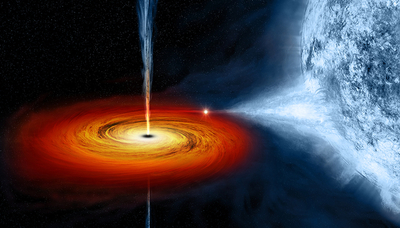
High-power lasers now create record-high numbers of electron-positron pairs, opening exciting opportunities to study extreme astrophysical processes, such as black holes and gamma-ray bursts.
Positrons, or "anti-electrons," are anti-particles with the same mass as an electron but with opposite charge. The generation of energetic electron-positron pairs is common in extreme astrophysical environments associated with the rapid collapse of stars and formation of black holes. These pairs eventually radiate their energy, producing extremely bright bursts of gamma rays. Gamma-ray bursts (GRBs) are the brightest electromagnetic events known to occur in the universe and can last from ten milliseconds to several minutes. The mechanism of how these GRBs are produced is still a mystery.
That’s where high-power lasers come in. In the laboratory, jets of electron-positron pairs can be generated by shining intense laser light into a gold foil. The interaction produces high-energy radiation that traverses the material and creates electron-positron pairs as it interacts with the nuclei of the gold atoms along its path.
A new review of the current breakthroughs in the creation of electron-positron pair plasma, its main challenges and the future of the field, authored by Lawrence Livermore National Laboratory (LLNL) physicist Hui Chen and SLAC National Accelerator Laboratory scientist Frederico Fiuza, appears in Physics of Plasmas.
“The ability to produce relativistic pair plasmas in the laboratory provides a unique opportunity to advance our understanding of these exotic plasma regimes and to benchmark current theoretical models and numerical simulations of the roles these plasma processes play in astrophysical environments,” Chen said.
Electron-positron pair plasmas are abundant in high-energy astrophysical systems, such as those associated with neutron star and black hole environments. The interactions of photons with each other and with strong magnetic fields lead to prolific pair creation via electromagnetic cascades. These pair plasmas are typically hot and can be accelerated to high speeds in the winds or jets associated with these compact astrophysical objects, including pulsar magnetospheres, jets from active galactic nuclei and GRBs.
Using ever more energetic lasers, Lawrence Livermore researchers in 2015 produced a record high number of electron-positron pairs, breaking a prior record from previous experiments at LLNL’s Titan laser in 2008, when Chen’s team had created billions of positrons.
In the past decade, extraordinary discoveries associated with extreme astrophysical plasmas have excited scientists and the public alike — from the first images of the plasma orbiting a black hole to the high-energy cosmic rays and radiation produced by relativistic jets and gamma-ray bursts to fast radio bursts from galactic neutron stars. It has long been long been known that the plasmas at the cores of these extreme environments are relativistic and often electron-positron-pair-dominated.
LDRD Project Title: Capturing a New State of Matter: Relativistic Electron-Positron Plasma
Principal Investigator:
Hui Chen
LDRD Project:
20-LW-021
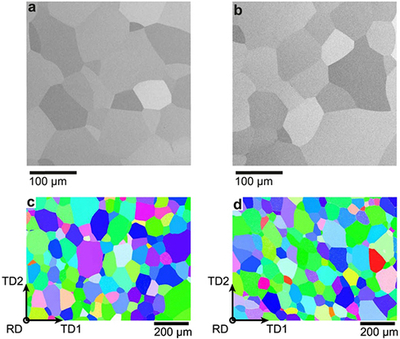
"Dwell fatigue" is a phenomenon that can occur in titanium alloys when held under stress, such as a jet engine's fan disc during takeoff. This peculiar failure mode can initiate microscopic cracks that drastically reduce a component's lifetime.
The most widely used titanium alloy, Ti-6Al-4V, was not believed to exhibit dwell fatigue before the 2017 Air France Flight 066 incident, in which an Airbus en route from Paris to Los Angeles suffered fan disc failure over Greenland that forced an emergency landing. The analysis of that incident and several more recent concerns prompted the Federal Aviation Administration and European Union Aviation Safety Agency to coordinate work across the aerospace industry to determine the root causes of dwell fatigue.
According to experts, metals deform predominantly via dislocation slip — the movement of line defects in the underlying crystal lattice. Researchers hold that dwell fatigue can initiate when slip is restricted to narrow bands instead of occurring more homogenously in three dimensions. The presence of nanometer-scale intermetallic Ti3Al precipitates promotes band formation, particularly when processing conditions allow for their long-range ordering.
Things get dicey when this banding behavior occurs across a contiguous group of 'soft'-oriented grains, termed a “macrozone,” researchers explained. The resultant deformation concentration, where the band meets a “hard”-oriented grain outside the macrozone, leads to a stress concentration, initiating the cracking process. Further complicating things, dislocation slip occurs intermittently in bursts or "avalanches," similar to how small fault slippage events can initiate more significant earthquakes. The magnitude and frequency of these slip avalanches strongly influence the initiation of dwell fatigue.
In a recent study by a multi-national team, including current and former Lawrence Livermore National Laboratory (LLNL) scientists, researchers used synchrotron X-rays to track discrete slip avalanche events in titanium held under load at room temperature. A team from Imperial College London provided specimens of specially prepared Ti–7Al, an alloy representing a surrogate for the primary phase in Ti-6Al-4V. The populations of two-point defect types were modulated across the specimens: interstitial oxygen content and the amount of ordered Ti3Al precipitates.
The study, published in Nature Communications, shows that where the Ti3Al exhibits ordering, slip avalanches are more severe in associated stress magnitude. In contrast, increasing the amount of interstitial oxygen appears to reduce the severity, promoting more frequent smaller avalanches.
"This work offers a novel, mesoscale view of the intermittent deformation events (little "bursts" of plastic slip) underpinning dwell fatigue, specifically how the frequency and magnitude of those events depend on oxygen content and alloying," said co-author and LLNL physicist Joel Bernier. "These data can help guide processing to avoid microstructures that have a deleterious effect on resistance to dwell fatigue."
Bernier helped execute high-energy X-ray diffraction microscopy measurements at the Cornell High Energy Synchrotron Source (CHESS) and performed the data reduction using the LLNL-developed HEXRD software library. The team quantified the frequency and magnitude of stress bursts resulting from slip avalanches and found that both types of point defects had pronounced effects on slip occurring on the crystal lattice's basal planes.
Researchers discovered that this deformation mechanism becomes easier to activate after the initial yielding, a softening known to be a precursor to damage accumulation and failure in instances of dwell fatigue. Among the key findings: higher concentration of oxygen interstitials reduced the average magnitude of the basal slip avalanches by promoting more frequent lower-magnitude events.
In contrast, expanding the size of ordered Ti2Al precipitates, by aging the material at an elevated temperature, increased both the frequency and the magnitude of slip avalanches, increasing the probability of crack initiation. According to the team, these findings can help optimize the processing of titanium alloys for resistance to dwell fatigue.
LDRD Project Title: Uncertainty Quantification and Experimental Design Using a Quantitative Forward Model for Kinematic X-Ray Diffraction
Principal Investigator:
Joel Bernier
LDRD Project:
20-ERD-044
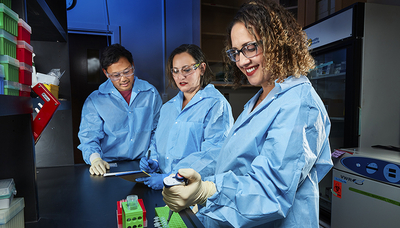
Immune responses could be supported by drugs to help people recover from brain infections caused by Rift Valley fever virus
Research by Lawrence Livermore National Laboratory (LLNL) scientists suggests that immune responses could be bolstered by drugs to help people recover from brain infections caused by an emerging pathogen.
The emerging pathogen studied by the team, known as Rift Valley fever virus (RVFV), is a disease that, to date, has been limited to outbreaks in Africa and the Arabian Peninsula.
But, as LLNL biologist and team leader Dina Weilhammer points out, “The reason we’re concerned about it is because, like the West Nile virus, the Rift Valley fever virus also could spread to North America from Africa.”
A paper about the team’s research has been published in the Public Library of Science (PLOS) Pathogens, a San Francisco-based online journal.
“Fundamentally, we were trying to understand how the immune response in the brain controls infections with Rift Valley fever virus. It’s a mosquito-borne disease that can infect many types of livestock and people,” Weilhammer said.
RVFV is a highly pathogenic virus capable of causing hepatitis, encephalitis, blindness, hemorrhagic syndrome and death in humans and livestock. It is most commonly seen in domesticated animals, such as cattle, buffalo, sheep, goats and camels. Upon aerosol infection with RVFV, there is an increased incidence of viral replication and tissue damage in the brain.
RVFV is classified as a category A biodefense pathogen by the National Institute of Allergy and Infectious Diseases due to its potential to be aerosolized as a bioterrorist agent. The disease was first reported among livestock in the Rift Valley of Kenya in the early 1900s; the virus was first isolated in 1931.
When the virus is contracted by mosquito bite, it usually produces flu-like symptoms and liver inflammation but rarely brain infection in humans. When the virus is released as an aerosol, brain infection occurs at a much higher incidence.
“Data from animal handlers who have usually been involved in butchering and who have been exposed to animals infected with RVFV, along with a handful of laboratory exposures, show a higher incidence of brain infections from aerosol exposure to the virus,” Weilhammer said
Mouse models have confirmed that what happens with the RVFV in humans also occurs in mice. Mice injected with the virus had, like humans, a low frequency of brain infections, while those exposed by aerosol had a higher incidence of brain infections.
In their research with mouse models, the team found that the RVFV infects a special immune cell called microglia that exists only in the brains of people and mammals.
“We were surprised by the robust response of the microglia to the RVFV,” Weilhammer said. “When the microglia are infected by the RVFV, these cells produced a robust type I interferon response, which is a first-line defense against viruses.”
The LLNL scientists are the first researchers to discover the strong response of the microglia to a RVFV infection and also are the first researchers to find that when the brain is attacked by a RVFV infection, the body recruits natural killer cells to assist the microglia in fighting the infection.
“What we’re thinking is: is there a way to help the natural killer cell response or the microglia with drugs be even better at controlling infections?” Weilhammer asked. “Our research suggests that there are immune responses that could be manipulated therapeutically to help people recover from brain infections.
LDRD Project Title: Investigating the Role of Innate Immunity in Viral Encephalitis Caused by Rift Valley Fever Virus
Principal Investigator:
Dina Weilhammer
LDRD Project:
17-LW-038
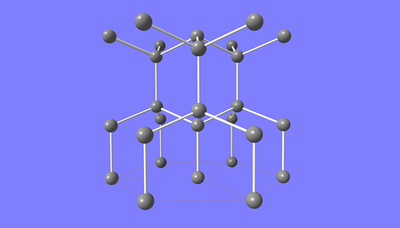
The graphite-diamond phase transition is of particular interest for fundamental reasons and a wide range of applications.
On very fast compression time scales, material kinetics hinder the transition from graphite to the equilibrium cubic diamond crystal structure that we commonly know as diamond. Shock wave compression of graphite typically requires pressures above 50 GPa (500,000 atmospheres) to observe the phase transition on the time scale of shock compression experiments. Further, the hexagonal polytype of diamond called Lonsdaleite has been observed in shock compressed material subsequent to meteorite impact events, suggesting that the time scale of compression plays a strong role in the phase transition.
In new experiments, Lawrence Livermore National Laboratory (LLNL) scientists have emulated the conditions of Lonsdaleite formation using picosecond time scale laser compression and observed the transition with state-of -the-art material characterization using femtosecond X-ray pulses.
The observation of Lonsdaleite subsequent to shock compression has been a persistent mystery, including debate over whether hexagonal diamond exists as an extended structure, or is cubic diamond with defects. Previous studies of the phase transition of graphite to diamond or Lonsdaleite under moderate shock compression support a diffusionless mechanism for the phase transition, but these studies did not observe atomic structure through the transition, so the transformation mechanism was not revealed.
“Lonsdaleite is formed under rapid compression – unique to shock compression,” said LLNL scientist Mike Armstrong, lead-author of a paper appearing in a special Shock Behavior of Materials issue of the Journal of Applied Physics. “There has been speculation for decades about the mechanisms and intermediate states of this phase transition and why it only forms under rapid compression. Here we show that the Lonsdaleite structure is likely an intermediate state in the phase transition to cubic diamond.”
In the experiments, the team used the unique capability of the Matter in Extreme Conditions instrument on the Linac Coherent Light Source to explore the phase transition behavior of carbon subsequent to a picosecond scale compression shock rise followed by ~100 ps of sustained compression. Ultrafast compression experiments have been used to investigate previously unknown states of matter under extreme elastic compression, sub-100 ps diffusionless phase transitions and strain rate dependent shock induced chemistry, but the response of graphite to ultrafast compression has not previously been investigated on picosecond time scales.
“These experiments are analogous to early time domain experiments to identify the transition state in physical chemistry,” Armstrong said. “Due to the very short observation time scale, this experiment has the capability to observe short-lived phase transition intermediates, analogous to the transition state in chemical reactions.”
Team members saw a phase transition where the product phase is strongly correlated to the initial phase. They observed highly textured, nearly single crystal product within 20 ps after compression.
“This confirms early speculation that this phase transition is diffusionless, and that Lonsdaleite may be an intermediate, even in the transformation to the equilibrium final state, cubic diamond,” said LLNL scientist Harry Radousky, a co-author of the study. “This experiment addresses decades of speculation about the nature of this phase transition, which has been the subject of considerable theoretical work.”
The experiments achieved the time and length scales of state-of-the-art simulations, which are normally extrapolated to compare with longer time scale experiments.
LDRD Project Title: Ultrafast Shock Kinetics of High-Atomic-Number Materials with High Throughput
Principal Investigator:
Jon Belof
LDRD Project:
16-ERD-037
Scientific Leadership and Service
LDRD projects are distinguished by their mission-driven creativity. LDRD-funded research often launches stellar careers, initiates strategic collaborations, produces game-changing technical capabilities, and even lays the foundation for entirely new fields of science. It is no surprise that every year, LDRD principal investigators from LLNL are recognized for the groundbreaking results of a project or long-term contributions to their fields. The following examples highlight recognition received during fiscal year 2022, attesting to the exceptional talents of these researchers and underscoring the vitality of Livermore’s LDRD program.
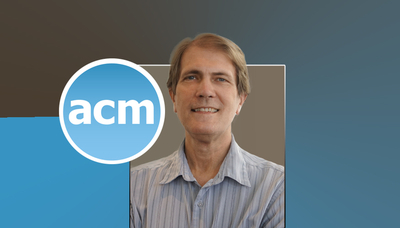
Bronis R. de Supinski
Fellow, Association for Computing Machinery (ACM)
The Association for Computing Machinery (ACM) has named Lawrence Livermore National Laboratory’s Chief Technology Officer for Livermore Computing (LC) Bronis R. de Supinski as a 2022 ACM fellow, recognizing him for his contributions to the design of large-scale systems and their programming systems and software.
The prestigious ACM fellows program honors the top 1% of ACM members for their outstanding accomplishments in computing and information technology and/or outstanding service to the organization and the larger computing community. Fellows are nominated by their peers, with nominations reviewed by a distinguished selection committee, according to ACM.
“I am pleased to be elevated to an ACM fellow. This honor validates that LLNL's LC and its Center for Applied Scientific Computing (CASC) perform world-leading computer science. Throughout my career, I have had the pleasure not only of standing on the shoulders of giants but also of working shoulder-to-shoulder with many outstanding computer scientists and computational scientists — many of whom still work at LLNL, while some now work (or always have) at other institutions. LLNL has provided me the opportunity to pursue interesting work of importance to the nation. I hope others will see this distinction as motivation to consider similar career choices."
As CTO of LC, de Supinski is responsible for formulating and overseeing implementation of LLNL's large-scale computing strategy, requiring managing multiple collaborations with the HPC industry and academia. He has led several research projects in CASC. He also has co-led the Advanced Simulation and Computing program's Application Development Environment and Performance Team (ADEPT), which is responsible for the development environment, including compilers, tools and runtime systems on LLNL's large-scale systems. He is the chair of the OpenMP Language Committee.

Chandrika Kamath
Fellow, The Society for Industrial and Applied Mathematics (SIAM)
The Society for Industrial and Applied Mathematics (SIAM), the world’s premier professional organization for applied mathematicians and computational scientists, has selected Lawrence Livermore National Laboratory research staff member Chandrika Kamath as a member of the SIAM fellows class of 2023.
The prestigious fellow designation is a lifetime honorific title and honors SIAM members who have made outstanding contributions to fields served by the organization. Fellows are nominated by SIAM members and chosen annually by a 16-member selection committee.
Kamath has worked at LLNL since 1997, where she specializes in analyzing data from scientific simulations, experiments and observations. An expert in data mining, Kamath also has led projects analyzing uncertainty in additive manufacturing, improving large-scale data exploration and analysis, integrating wind energy on the power grid and on intelligent reduction of data from exascale simulations. Her expertise includes image and video processing, feature extraction, dimension reduction, pattern recognition, high performance computing and machine learning. Kamath’s current focus is on techniques for sampling and surrogate modeling, especially for small data sets in high dimensions.
"I am thrilled to have Chandrika honored in this way for her stellar career” said Bruce Hendrickson, LLNL’s associate director for Computing. “She has been a pioneer and leader in embracing data science for scientific and engineering applications.”
At LLNL, Kamath served as project lead and contributor for Sapphire, a project to develop scalable algorithms for the interactive exploration of large, complex multi-dimensional scientific data. The Sapphire team won an R&D 100 award in 2006.
Kamath is among the top 2% of the most cited researchers worldwide throughout their careers, according to Stanford University. She holds six patents in data mining and organized various data mining workshops and conferences, including the SIAM Conference on Data Mining, where she served as the chair of the conference’s steering committee from 2007-2014. Her book, "Scientific Data Mining: A Practical Perspective," was published by SIAM in 2009. She also is one of the three founding editors-in-chief of the Wiley journal, Statistical Analysis and Data Mining, where she focused on the practical applications of data analysis techniques.
Prior to joining LLNL, Kamath was a consulting software engineer at Digital Equipment Corporation, developing high-performance mathematical software. She holds a Ph.D. and master’s degree in computer science from the University of Illinois at Urbana-Champaign and earned her bachelor’s degree in electrical engineering from the Indian Institute of Technology in Bombay. SIAM, the world’s largest scientific society devoted to applied mathematics, comprises more than 14,000 computational mathematicians, computer scientists, numerical analysts, engineers, statisticians, physicists, educators and students from more than 100 countries.
The goals of the fellows program are to honor SIAM members recognized by their peers as distinguished for their contributions to the discipline, to help make outstanding SIAM members more competitive for awards and honors and support the advancement of SIAM members to leadership positions in their own institutions and in the broader society, according to the organization’s website.
“When I changed my field from parallel numerical algorithms to scientific data mining over 25 years ago, I wasn't sure how it would turn out; I have since worked on many interesting and challenging problems,” Kamath said. “Finding solutions and learning multiple disciplines in the process has been its own reward. Being selected a SIAM fellow is icing on the cake. I am honored, and grateful to all those who supported me along the way.”
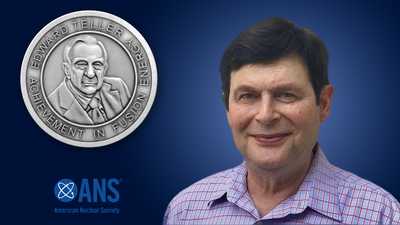
Physicist Otto "Nino" Landen receives prestigious Edward Teller Award
Otto “Nino” Landen, a distinguished member of the technical staff and the inertial confinement fusion (ICF) experiments group leader at Lawrence Livermore National Laboratory (LLNL), has been awarded the 2023 Edward Teller Medal.
The Fusion Energy Division of the American Nuclear Society (ANS) presented the award to Landen this week during the International Conference on Inertial Fusion Sciences and Applications 2023 (IFSA) held in Denver, Colorado. Landen was honored for his “pioneering contributions to ICF and high energy density science (HEDS) and for (his) leadership in achieving ignition on the National Ignition Facility (NIF).”
Landen’s contributions to the scientific community have been widely recognized. He was elected a fellow of the American Physical Society in 2002 in recognition of his pioneering work in the fields of picosecond laser-plasma interactions, advanced diagnostics, X-ray-driven ICF implosions and time-dependent hohlraum symmetry control. In 2022, Landen was part of an LLNL burning plasma team that was awarded the John Dawson Award for Excellence in Plasma Physics Research.
“I have benefited over the years from the freedom to explore and develop new techniques at LLNL’s state-of-the-art ICF and HEDS instrumentation, target fabrication capability, and high-power laser facilities,” Landen said. “I’m indebted to the dedicated teams I have worked with and especially grateful for their patience and persistence to get past disappointments and for their enthusiasm in following up on successes. I am truly honored to receive this recognition.”
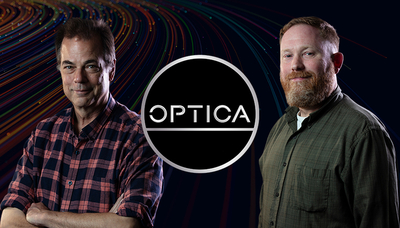
Two LLNL scientists named Optica Senior Members
Lawrence Livermore National Laboratory (LLNL) scientists David Gibson and Paul Pax have been named senior members of Optica (formerly OSA). Senior membership status recognizes members with more than 10 years of professional experience in optics or an optics-related field.
Gibson, a staff scientist in the National Ignition Facility and Photon Science (NIF&PS) Directorate, is working on directed-energy research projects such as diagnostics development and analysis for the diode-pumped alkali laser efforts. Recently, he supported an upgrade to NIF’s Advanced Radiographic Capability for improving the pulse contrast and studies of multi-pulse damage thresholds for NIF optics for potential future diagnostics.
Pax, a staff scientist in the Computational Engineering Division, has worked on many projects in NIF&PS over his 18 years at LLNL. He is leading optical modeling for the design of a new high-gain amplifier for NIF, a critical component of NIF sustainment. Most recently, he led the construction and deployment of a front-end system for a high-energy laser project.
“I’m honored to have been nominated to the 2023 class of Optica senior members,” he said. “It's gratifying to be recognized by the Lab and Optica society. The Lab’s an amazing place, there's so much going on here — so much opportunity to learn!”
“It’s a great honor to be recognized by Optica and I appreciate the support for my nomination,” Gibson said. “Sometimes it’s hard to tell how broad of an impact you are having, so this is very gratifying. In my career at LLNL, I’ve had the opportunity to work on so many important, challenging projects.”
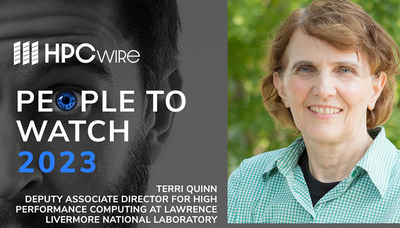
Terri Quinn named among "2023 People to Watch" by HPCWire
The publication HPCwire announced Lawrence Livermore National Laboratory’s Deputy Associate Director for High Performance Computing (HPC) Terri Quinn has been named among its “People to Watch” for 2023.
Celebrating its 21st year, the annual HPCwire program recognizes HPC professionals who play leading roles in driving innovation within their chosen fields and make significant contributions to society in general. To date, the publication has recognized 200 people in HPC for their achievements, including luminaries from leadership HPC centers, technology companies and community-led projects.
In her role as Livermore’s deputy AD of HPC, Quinn establishes long-range directions and priorities for the Lab’s Computing Directorate and for the Multiprogrammatic and Institutional Computing program, which provides cost-effective computing services to LLNL programs and scientists. Quinn also is associate program director for Livermore Computing (LC) for the Weapons Simulation and Computing program, where among other responsibilities, she is helping Chief Technology Officer for LC Bronis de Supinski prepare for the exascale-class supercomputer El Capitan. El Capitan is scheduled for delivery at LLNL later in 2023.
“I am delighted to be recognized by HPCwire,” Quinn said. “I feel the recognition has as much to do with the stature of Livermore Computing as the opportunity I’ve had to contribute. I was nudged into HPC early in my career, expecting to move on in a few years. But once I got involved, I was hooked and didn’t want to leave. I was fortunate to get that first nudge.”
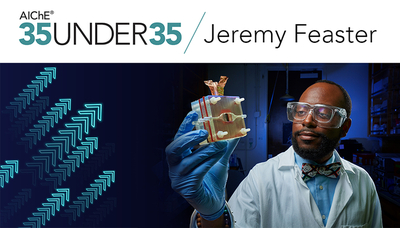
Jeremy Feaster named to American Institute for Chemical Engineering’s "35 Under 35"
Lawrence Livermore National Laboratory staff scientist Jeremy Feaster has been named as one of the American Institute for Chemical Engineering’s (AIChE) “35 Under 35” award winners for 2023. The recognition honors chemical engineers under the age of 35 who have made outstanding contributions to their field and to the chemical engineering community, according to the organization.
Feaster’s research at LLNL focuses on designing and creating 3D-printed electrochemical reactors that convert air into fertilizer and carbon dioxide into valuable products such as plastics or fuels, to help address climate change and sustainability concerns. He also serves as co-chair for LLNL’s African American Body of Laboratory Employees.
Feaster earned his master’s degree and Ph.D. in chemical engineering from Stanford University after completing his bachelor’s degree in chemical and biomolecular engineering at Georgia Tech.
“This award means a lot to me and to my family, friends and community,” Feaster said. “From the beginning, I’ve wanted to use chemistry to help communities and solve problems. Seeing how chemical engineering can be used to serve people inspired me to pursue it as a degree and a career, and my heart for using chemistry and service to help communities has only grown. I hope that through this award, I can continue to inspire more students — especially from underserved communities — to want to learn more about chemistry and chemical engineering, not just for the science, but for building a sustainable and compassionate society.”



